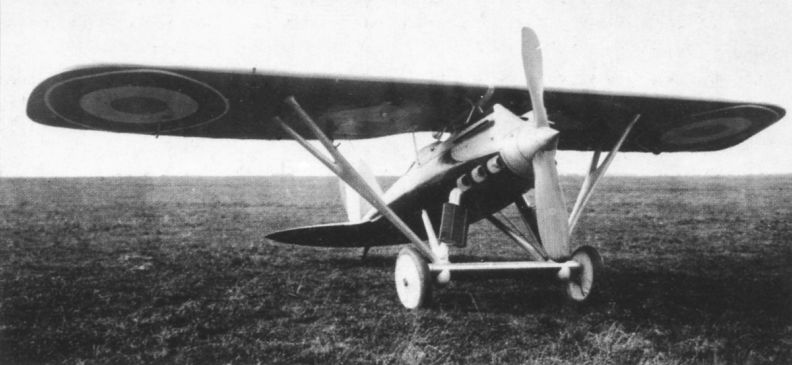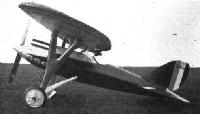Nieuport-Delage Ni-D 48
В 1926 году в рамках обнародованных требований ВВС Франции на перспективный легкий экономичный одноместный истребитель компания "Nieuport" предложила вариант Nieuport-Delage Ni-D 48. Самолет отличался крылом типа парасоль, прикрепленным к поперечной оси шасси с помощью больших Y-образных подкосов, и оснащался двигателем Hispano-Suiza 12Jb мощностью 400 л. с. Новый самолет был представлен в 1926 году на престижном Парижском авиасалоне, после чего прошли интенсивные летные испытания, на которых самолет продемонстрировал максимальную скорость 275 км/ч. В июле 1929 года он потерпел аварию.
Ni-D 48bis, построенный следом, оснащался двигателем Hispano-Suiza 12Hb и отличался увеличенным стабилизатором. После нескольких полетов дальнейшее усовершенствование самолета прекратили, но в 1930 году на самолет поставили звездообразный двигатель Lorraine Algol мощностью 300 л.с. с кольцевым обтекателем (кольцо Тауненда), поскольку самолет готовили для участия в авиагонках на Кубок Мишлен (Coupe Michelin). Пилотировать машину должен был Рене Полан, но авария не позволила самолету принять участие в соревнованиях, хотя после того, как самолету присвоили новое обозначение Ni-D 481, он принимал участие в ряде французских авиашоу, где продемонстрировал фигуры высшего пилотажа. В 1936 году самолет списали.
Показать полностьюShow all
Flight, December 1926
The Paris Aero Show 1926
NIEUPORT-ASTRA.
THE Nieuport-Astra Company, which originated in 1915 the single-seater fighter type of military aeroplane with its Bebe Nieuport, is the largest purveyor of fighting machines to the French Military Air Service, where the majority of escadrilles de chasse are equipped with the Nieuport 29 C.I type (300 h.p. Hispano-Suiza). The replacement of this type by a more powerful machine caused the French Under-Secretariat of Aeronautics to hold in 1924 and 1925 a competition for single-seater fighters, as a result of which orders were let to several manufacturers, including the Nieuport-Astra Company, Loire-Gourdou-Leseurre, and Michel Wibault.
The Nieuport-Delage fighter adopted by the French Military Air Service, type 42 C.I (500 h.p. Hispano-Suiza), will be exhibited at the Salon de l’Aviation, as will be a new category of military aeroplane, called a "light fighter," in the form of type 48 C.1 (400 h.p. Hispano-Suiza). The principal military difference between the two types is that the light fighter only carries two synchronised machine guns, whereas the heavy fighter mounts two wing guns besides.
Constructionally the two types are almost identical. The fuselage is of the monocoque type, and is built in two halves, split along the horizontal, of strips of glued tulip wood and spruce longerons. In the forward portion the fuselage is reinforced by a framing of riveted sheet duralumin which is bolted to the monocoque skin. This framing gives the machine great rigidity and resistance against torsional stresses, for it not only serves as the engine mounting, but also forms the central structure to which the upper wing and the undercarriage are fixed. The framing extends as far back as the pilot's cockpit.
The top wing has duralumin box spars and plywood ribs, while the bottom winglet is entirely timber-built. The axle fairing is in the shape of an aerofoil, and thus contributes to the sustentation. The top wing is braced to the undercarriage by means of Y-type struts. In the type 48 C.1 there is no bottom winglet. The wing bracing struts as well as the undercarriage struts are built of riveted sheet duralumin. The cabane struts are duralumin tubes.
<...>
Specification of the Nieuport-Delage 48 C.1 Light Fighter
Engine, 400 h.p. Hispano-Suiza; span, 10.00 m.; length, 6-40 m.; height, 2-78 m.; wing area, 18-38 sq. m.; axle fairing area, 1 sq. m.; total supporting area, 19-38 sq. in.; weight equipped (empty), 1,032 kgs.; disposable load, 98 kgs.; fuel load (1 1/2 hours), 160 kgs.; weight, loaded, 1,290 kgs.
Official Performances (S.T.Ae. Tests)
Altitude. Climbing Time. Maximum Speed
Metres. Mins Secs Km. p.h.
1,000 2 14 275
2,000 4 21 272
3,000 6 54 269
4,000 10 39 263
4,500 13 12 -
5,000 16 16 255
5,500 20 56 -
6,000 27 24 -
6,500 40 16 -
The "weight equipped" does not include any heating apparatus or oxygen inhalator, as they are not deemed necessary at the altitudes at which this machine will be called upon to perform.
The disposable load includes the weight of the pilot and that of 700 rounds of ammunition.
THE two machines exhibited by this firm were generally similar, the type 42 C.1 being the older type, while the type 48 C.1 is the very latest product of M. Delage, the firm's chief designer. Both machines are of typical Nieuport-Delage lines, and the main difference between them is that in the type 48 the small lower plane has disappeared altogether, the wing bracing is in the form of a single "Y" strut on each side, the struts being built up from sheet duralumin of fairly thick gauge, but without internal stiffening. As is usual, the machines were beautifully finished, and it is worth noting that the cockpit arrangements were among the best in the show, a very great deal of trouble having quite obviously been taken to ensure the best lay-out for the instruments, armament, etc. A feature of both Nieuport-Delage machines is the duralumin "backbone" unit, to which all the main weights such as engine, undercarriage, crew, equipment, etc., are attached, and for which the monocoque rear portion of the fuselage forms but a streamline fairing.
Показать полностьюShow all




